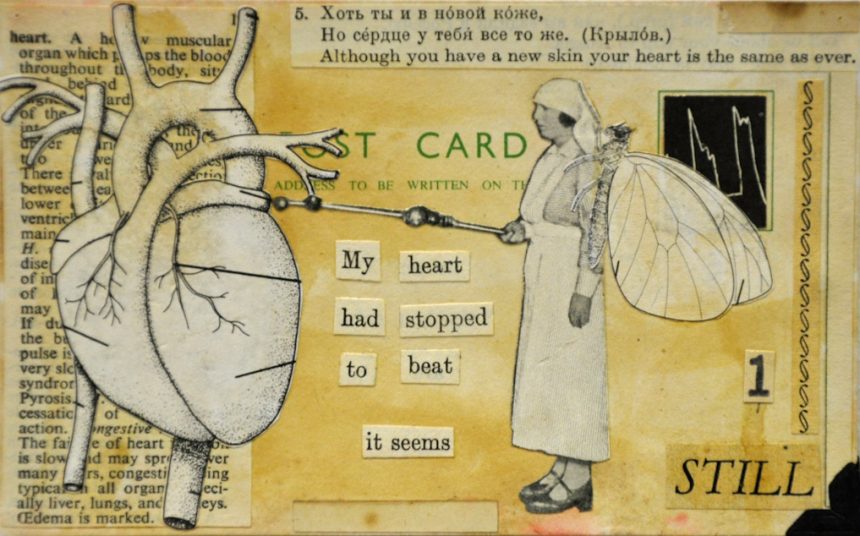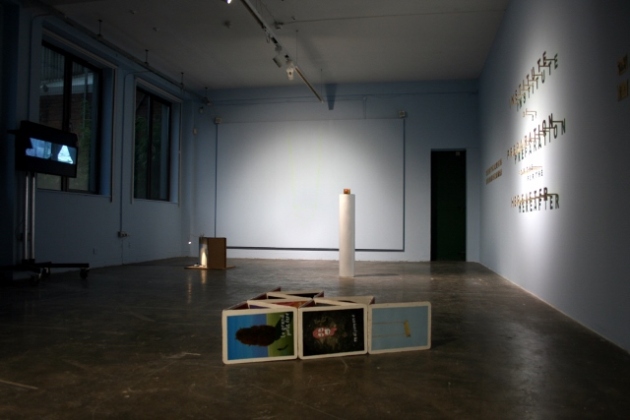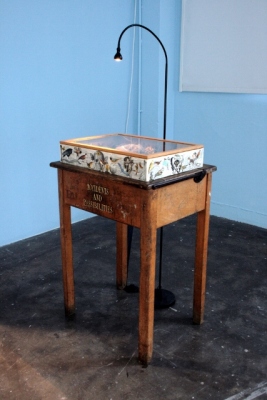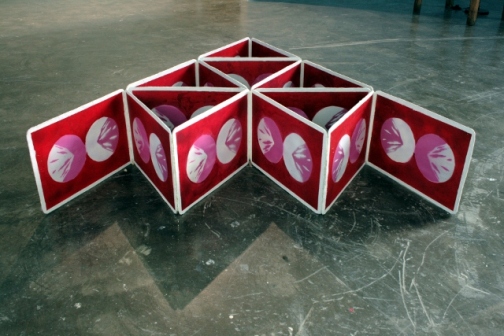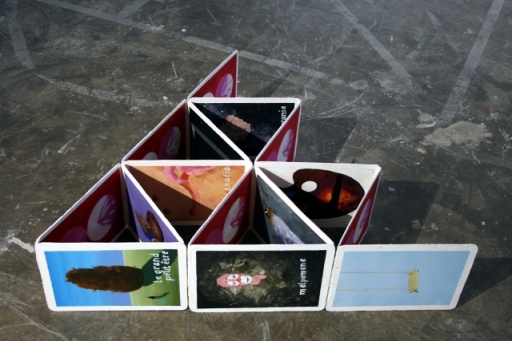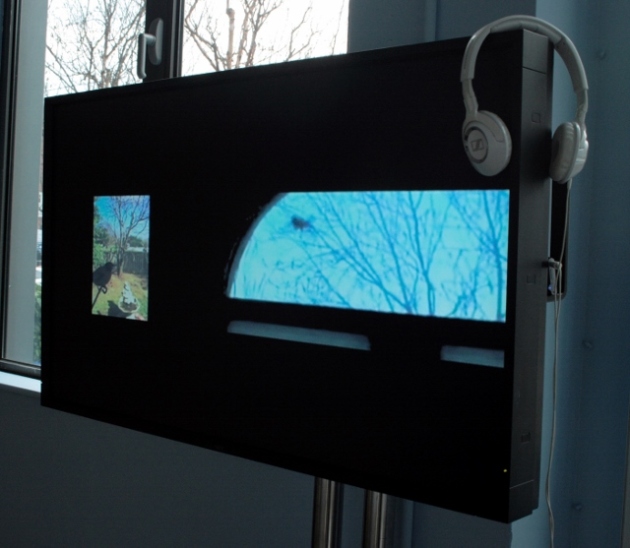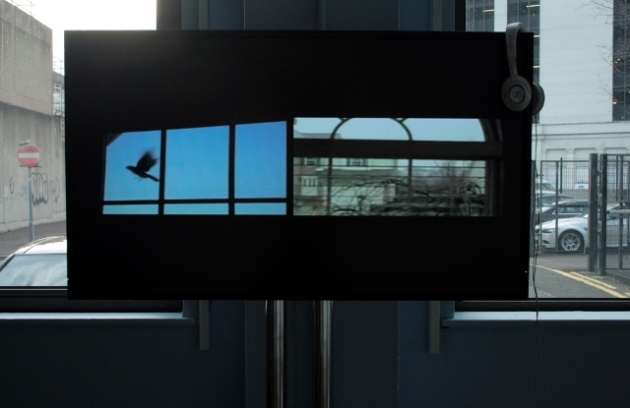Distributed through Space and Time
5 December 2013 – 19 January 2014. Golden Thread Gallery, Belfast
Review by Slavka Sverakova
Curated by Sarah McAvera the exhibition takes its title from one line in Canto 1 of Pale Fire(1962) by V Nabokov. The curator limited the number of artists to three, possibly in relation to the small size of the Project Space at the GTG. Deirdre McKenna (1973), Zoe Murdoch and Christopher Campbell (1983) made good use of the scale of the room as well as of the daylight. Only one exhibit had to turn its back on the windows to protect visibility, the Incantation video by McKenna. Her two paintings, Campbell’s two floor sculptures and Murdoch’s box and 36 collages benefited (like many a viewer) from the traditional viewing conditions.
If the first impression zooms on the visibility as unifying principle it is not entirely accidental. The curator selected the passage that refers to space and time, both phenomena tightly related to contemporary visual arts. Moreover, the first Canto of the 999 lines of a poem either by the fictional John Shade or by the fictional commentator Charles Kinbote, offer glimpses of the supernatural and encounters with death, stretching both time and space beyond our world. The exhibition insists on making intention and inspiration linked to a literary source, of course not exhausted by it. The tradition of the inventive aesthetic response to a pre-existing literary source has rich history, in the Western culture represented by the biblical stories. Artists during the Middle Ages, Renaissance and Baroque developed numerous paradigms of visualizing what is not, what might be.
Nabokov offers a free choice whether to read Pale Fire straight through or via reckless jumping from the poem to commentary and back. Consequently, the question is not what reading leads to “correct interpretation”, rather, it is why a linear and non-linear narratives are posited as equivalent. One answer lies in the similarity between Nabokov and contemporaneous classical music – the notation allowed interpreter to play it vertically, horizontally or in circles. The other is locked in the novel, all over it. Starting with the title: pale fire appears as a metaphor for inspiration in Shakespeare’s Timon of Athens (Ach 4 scene 3) the moon’s an errant thief/And her pale fire she snatches from the sun. Some commentators noted also a link to Hamlet (Act 1 scene 5) as a glow-worm gins to pale his uneffectual fire. Nabokov inserted a reference in the Foreward: the pale fire of the incinerator.
If the title’s vagaries surprise by leaking out to other realms of art they also give permission to imagination to fly through the barrier of the very text into a meaning beyond.
As a consequence, the artists felt encouraged to present tenuous relationships between the parts that both offer a covert coherence and disturb it.
Near the entrance Zoe Murdoch installed Accidents & Possibilities,a glass topped box full of found objects, looking down upon its neighbour House of Elysium by Christopher Campbell.
Zoe Murdoch, Accidents&Possibilities, Mixed media and found objects, n.d.
Accumulation, hording, lies at the far end of flagrant discord with acute angles of clarity and order. Murdoch’s diverse objects are enclosed in right angled case.
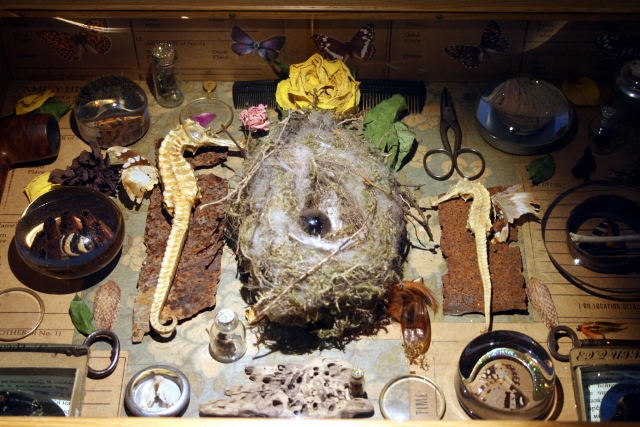
Campbell covers the surface of the rectangles with paint, thus jumping between geometry an illusion.
Christopher Campbell, House of Elysium, Fibre board, acrylic, graphite, 2013
Its title may be connected to the dystopian science fiction film Elysium, in which the rich safe people live in a well designed future.
It is to both artists’ credit, that the outcome works well as a guarantee of stable fiction. Campbell exhibits a sculpture that looks like a model of a house with a glass in the wall and on the top. Connected to electricity it animates a toy butterfly trapped inside(sorry, no image)
Murdoch made thirty six collages placed unframed on the wall, literary distributed in time.
My first response came as a reminiscence of Max Ernst’s superb graphic novel une semaine de bonte(1933) (A Week of Kindness).
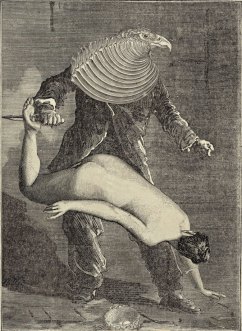
Max Ernst, une semaine de bonte,1933
Murdoch is less unsettling as she has trapped the surrrealist mode into the depth of the image, devoting the surface meaning to a lighter play.
The motive of entrapment appears also in the video by McKenna Incantation, whereas her wall painting Phantom makes unusual demands on perception, its pale yellow seems to seep through the white wall into eternity of nothing. On the other hand, her Lipstick of her Smoke is a robust gesture of clearly legible letters proclaiming its belonging to the Nabokov’s story: Institute of Preparation for the Here and After.
I watched the video without the sound, on purpose. The composition reminded me of folk songs and classical sonatas, with motifs re-appearing in different constellations, like a refrain in psalms.
I asked her how it was made. She gave me a permission to cite her answer in full:
So firstly this is the first time I have made a video to show in a gallery context, I wanted to explore a new mode of creativity and it just seemed to be a fit for the pictures in my head.
In response to the to the task set by the curator (Sarah) I began reading the book Pale Fire, I wanted to let the book inspire me as opposed to dictate to me. I feel that there are so many compositions and concepts to draw on inside the text that I thought I should respond in a way that transmitted the energy of the text.
The video is called Incantation and it responds to the feeling that infiltrates the book, of nature being in some way pervasive and at some point a bird hits a window in the text. This is in some traditions a message of a death or a message from the spirit world. I wanted to create a tension between the wild (outside) and the domestic (inside). The birds hitting the window, underlines the invisible division between our natures. The sound builds on the feeling of urgency for this occupation of space. (in subconscious way). This relates to the text on the wall, which has been taken directly from book the INSTITUTE OF PREPARATION FOR THE HEREAFTER. At times the hitting of the window reminds me of the sound of a typewriter being operated.
I made the video using a selection of you tube clips that I edited. The footage is of mixed quality in terms of resolution, this I like. I edited it using a split screen as I felt it was an opportunity to create the sonic dynamic, and visual composition, with one impacting on the other.
The apple sculpture is meant to be a type of alter between the video work and the text work. It will wilt for the duration of the exhibition and will be finished when its over (the show).
By the “apple structure” is meant the small object on a plinth titled Fortress.
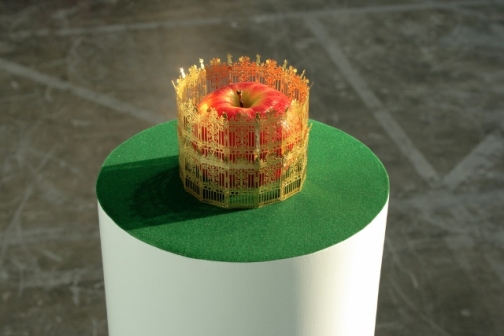
Deirdre McKenna, Fortress, 2013
All exhibits subscribe to the open ended path to a meaning, the grounding characteristic of Nabokov’s novel. Like Nabokov they favour a delusion that all is equally real and uncertain. They make their authorship only one of several, by using other art, found objects and borrowed ideas. They do not promise radical revelation, yet they offer one: a small change, that proverbial touch of butterfly’s wing, makes a substantial difference to the intimacy of relationship between part and part, between intended interpretation and robust immersion in one’s art practice. The relationship between objective truth and imagination prospers best in fictional space and time. After all, Nabokov makes the place where Shade and Kinbote live – a fiction. Aspiring poioumena.
Images courtesy GTG and Deirdre McKenna


